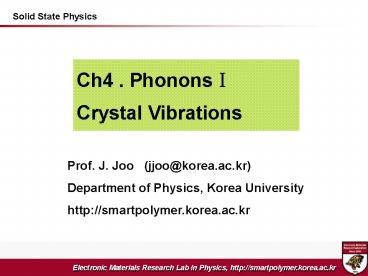Ch4 . Phonons? Crystal Vibrations
1 / 15
Title: Ch4 . Phonons? Crystal Vibrations
1
Solid State Physics
Ch4 . Phonons? Crystal Vibrations
Prof. J. Joo (jjoo_at_korea.ac.kr) Department of
Physics, Korea University http//smartpolymer.kore
a.ac.kr
2
4.1 Vibrations of Crystals with Monatomic Basis
(1)
- ? Primitive cell ?? ??? ??(? ??? ?? monatomic)
- ? ? crystal ? elastic vibration? ????
- ?? ????? wave (? ????)? ????
- ???? ?? ?(F)? ???? ? vibration
- ?? ?? (? Matter)? ??? ??? ?? ???
vibration - ? Phonon??? Energy of a lattice vibration is
quantized. - The quantum of energy is Phonon
- ? Wave ?? ??? ??? ???? ??? ???..
?? ??? ??
??? ?? transverse (wave) displacement
??? ?? longitudinal (wave) displacement
two mode
one mode
3
4.1 Vibrations of Crystals with Monatomic Basis
(2)
- lt ??? ?? Monatomic ?? ? ?? gt
- ? ?? crystal ? elastic ? vibration response ?
??? ?? linear ? ?? - ( ? F kx Hookes law )
- Fs ? us or E ? us2
- (?) (??)
- ?? Energy ? us3 ? ???? ??
high temp. - ? Consider,
- C ??? ?? (?? ?monatomic )
- M ?? ?? (?? ?monatomic )
- ? ? longitudinal ??? transverse ? ??? C ? ??
- ? S ???? ? Fs C(us1-us) C(us-1-us)
C(usp-us) - ?p1 C(usp-us)
4
4.1 Vibrations of Crystals with Monatomic Basis
(3)
- ? ?? nearest-neighbor ????? dominant ? ??? ??, ?
p1 - ? Fs C(us1-us) C(us-1-us)
- Note us ? ??? time dependent ? exp(-i?t)
- ?, us us0 exp(-i?t)
- ? -M?2us C(us1us-1-2us) ?
- ? Let the general solution for us as
- us u0 exp(iksa) exp(-i?t) ?? x
x0sin(kx- ?t) - ?... and
- usp u0 exp(ik(sp)a) exp(-i?t)
lattice const.
5
4.1 Vibrations of Crystals with Monatomic Basis
(4)
- ? ??? ??? ???? ??
- ? At the boundary of the 1st B.Z. (kp/a)
? The plot of ? vs. k
?
Longitudinal
Transverse C? ??
slope is zero
k
p/a
-p/a
Special signification of phonon wavevectors lies
on the zone boundary
6
4.2 First Brillouin Zone
- ?? ??? ???? ??? elastic wave? ????? ??? ??
- ? only the 1st B.Z.
- ??
- ? 1? 2?? physical property? ??
- ?? (?, 1st B.Z.)? ??? ??? ?? ??? ??? ??
?
Extended zone
1
2
k
0
p/a
2p/a
-p/a
-2p/a
7
4.3 Group Velocity
- ? ?? elastic wave packet ? ????
- ? group velocity
- ?)
the velocity of energy propagation in the medium
no propagation!! ? the wave is standing wave
? zero net transmission velocity (note)
diffraction condition
8
4.4 Long Wavelength Limit
?gtgta
? continium theory of elastic wave
?2a
9
4.5 Two Atoms per Primitive Basis (1)
- Looking for phonon dispersion relation
- in crystals with 2 different atoms /
primitive basis - For each polarization mode, the dispersion
relation (? vs. k) - acoustic branch (LA, TA)
- and
- optical branch (LO, TO)
- Consider a cubic crystal with 2 atoms
- Consider the interaction
- between the n, n, atoms
basis associated with primitive cell
Longitudinal or transverse mode
10
4.5 Two Atoms per Primitive Basis (2)
- Looking for a solution in the form of a traveling
wave
eq.?
eq.?
11
4.5 Two Atoms per Primitive Basis (3)
- ?
- ? ? ? ?? 4? ???
- ?? ???? ?? 2?? ??? ???? ??,
- ?, kaltlt1 (?? ????) and kap (zone boundary??)
- ?
- ?
?, ka?0
??
12
4.5 Two Atoms per Primitive Basis (4)
- Transverse mode ? ??? ???? (Fig.8a)
- Ge at 80K
- For transverse optical branch,
- ? ? the atoms vibrate each other,
- but their C.O.M. is fixed
- ? we may excite a motion of this type
- with el. field of a light wave
- ? the branch is called the optical branch
- For transverse acoustical branch, at a small k,
uv - ? the atoms (and their C.O.M.) move together,
- as in the long wavelength acoustic
vibrations - ? acoustic branch
?? (eq.? and eq. ?)
TO TA in a diatomic linear lattice
13
4.6 Quantization of Elastic Waves
- The energy of a lattice vibration is quantized
- the quantum of lattice vibration energy is
called a phonon - (similar to the photon of
the EM wave) - Note Phonon? ??? ?? ??
- Neutron scattering can map entire B.Z., but
poor resolution - (needs a special places such as Natl Lab.)
- 2. Raman scattering (polariton scattering)
- high resolution and for optical mode
- 3. Brillouin scattering (photon scattering)
- very high resolution and for acoustic mode
14
4.7 Phonon Momentum
- A phonon of wave vector K
- Interacts with photons, neutrons, and electrons
- For most practical purposes, a phonon acts as if
its momentum wave
crystal momentum - Note For a x-ray photon by a crystal (photon
elastic scattering) - momentum conservation
- reciprocal lattice vector
- incident photon wave vector
- scattered photon wave vector
- If the scattering of the photon is inelastic
- ? with the creation of a phonon (K),
- then the wave vector selection rule is
- ? if a phonon K is absorbed in the process,
- ? For an inelastic scattering,
?
?
15
4.8 Inelastic Scattering by Phonons
- ? the energy conservation is
- ???? ??? neutron? ???
- the energy of the phonon created (), or
absorbed (-)































